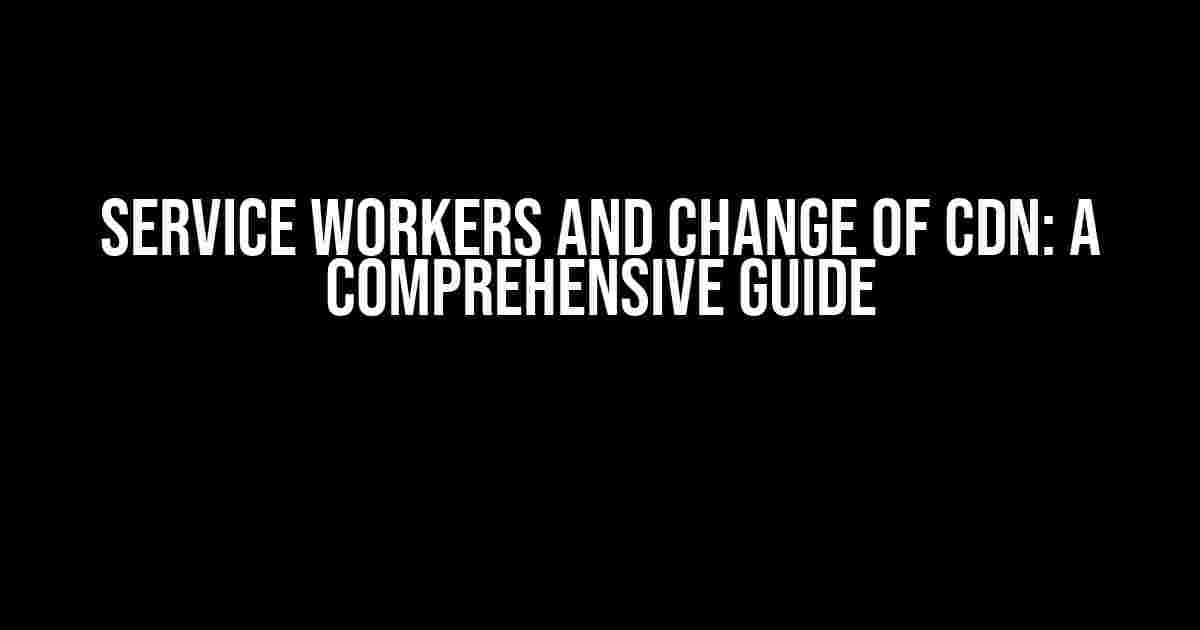Ah, Service Workers! Those magical creatures that can revolutionize the way your web application interacts with the network. But, what happens when you decide to change your Content Delivery Network (CDN)? Do you know how to update your Service Worker to reflect the changes? Fear not, dear developer, for we’ve got you covered!
What are Service Workers?
Before we dive into the juicy stuff, let’s take a step back and explain what Service Workers are. A Service Worker is a script that runs in the background, between your web application and the network. It acts as a proxy, allowing you to intercept and modify requests and responses. This enables you to implement features like caching, push notifications, and background sync.
The Power of Service Workers
Service Workers are incredibly powerful, but they can also be a bit tricky to work with. One of the biggest advantages is that they allow you to cache resources, making your application faster and more reliable. But, what happens when you change your CDN? If you’re not careful, your Service Worker might start caching resources from the old CDN, leading to all sorts of issues.
Why Change Your CDN?
There are many reasons why you might want to change your CDN. Perhaps you’re looking for better performance, more features, or a more cost-effective solution. Whatever the reason, changing your CDN can be a complex process, especially when it comes to updating your Service Worker.
The Challenges of Changing Your CDN
When you change your CDN, you need to update your Service Worker to reflect the new URL structure. This can be a daunting task, especially if you’re not familiar with the intricacies of Service Workers. But fear not, dear developer, for we’ve got some step-by-step instructions to help you through the process.
Step 1: Update Your Service Worker Script
The first step is to update your Service Worker script to reflect the new CDN URL. This involves updating the cache names and the URLs used in your cache logic.
// old service worker script
const cacheName = 'my-cache-v1';
const cdnUrl = 'https://old-cdn.com';
// update the cache name and CDN URL
const cacheName = 'my-cache-v2';
const cdnUrl = 'https://new-cdn.com';
Step 2: Update Your Cache Logic
Once you’ve updated your Service Worker script, you need to update your cache logic to reflect the new CDN URL. This involves updating the cache keys and the URLs used in your cache logic.
// old cache logic
caches.open(cacheName).then(cache => {
cache.keys().then(keys => {
keys.forEach(key => {
if (key.includes(`${cdnUrl}/`)) {
cache.delete(key);
}
});
});
});
// update the cache logic
caches.open(cacheName).then(cache => {
cache.keys().then(keys => {
keys.forEach(key => {
if (key.includes(`${cdnUrl}/`)) {
cache.delete(key);
}
});
});
});
Step 3: Update Your HTML Markup
Now that you’ve updated your Service Worker script and cache logic, you need to update your HTML markup to reflect the new CDN URL. This involves updating the URLs used in your HTML tags.
<!-- old html markup -->
<script src="${cdnUrl}/javascripts/script.js"></script>
<!-- update the html markup -->
<script src="${cdnUrl}/javascripts/script.js"></script>
Step 4: Test Your Service Worker
Now that you’ve updated your Service Worker script, cache logic, and HTML markup, it’s time to test your Service Worker. This involves checking that your resources are being cached correctly and that your Service Worker is intercepting requests correctly.
Testing Your Service Worker
There are several ways to test your Service Worker, including:
- Using the Chrome DevTools
- Using the Firefox Developer Edition
- Using a third-party testing tool like Lighthouse
Common Issues When Changing Your CDN
When changing your CDN, there are several common issues that can arise. These include:
- Cached resources not being updated
- Service Worker not intercepting requests correctly
- HTML markup not being updated correctly
- Cache keys not being updated correctly
| Issue | Solution |
|---|---|
| Cached resources not being updated | Update the cache names and URLs in your Service Worker script |
| Service Worker not intercepting requests correctly | Check that your Service Worker is registered correctly and that the scope is set correctly |
| HTML markup not being updated correctly | Check that the HTML markup is updated correctly and that the URLs are pointing to the new CDN |
| Cache keys not being updated correctly | Update the cache keys in your Service Worker script to reflect the new CDN URL |
Conclusion
Changing your CDN can be a complex process, but with these step-by-step instructions, you should be able to update your Service Worker to reflect the changes. Remember to update your Service Worker script, cache logic, and HTML markup, and don’t forget to test your Service Worker to ensure that everything is working correctly.
By following these instructions, you’ll be able to ensure a seamless transition to your new CDN, and your users will never even notice the difference. Happy coding, dear developer!
Optimized for the keyword “Service Workers and Change of CDN”, this article provides comprehensive guidance on updating Service Workers when changing CDNs. With clear instructions and explanations, developers can ensure a smooth transition to their new CDN.
Frequently Asked Questions
Get the lowdown on Service Workers and Change of CDN
What are Service Workers, and how do they impact my website?
Service Workers are scripts that run in the background, allowing you to manage network requests, cache resources, and provide offline support. They can significantly impact your website’s performance and user experience. Think of them as a game-changer for your online presence!
How do Service Workers interact with my CDN?
When you integrate a Service Worker with your CDN, it can cache resources from the CDN, reducing the load on your servers and improving page load times. This dynamic duo can help you deliver a faster, more reliable user experience. Think of it as a match made in heaven!
What happens to my Service Worker when I change my CDN?
When you switch to a new CDN, your Service Worker needs to be updated to point to the new CDN. This involves updating the Service Worker’s configuration and caching rules to ensure a seamless transition. Don’t worry, it’s a relatively painless process, and we’ve got your back!
Can I use multiple CDNs with a single Service Worker?
Yes, you can configure your Service Worker to work with multiple CDNs. This approach is useful when you need to use different CDNs for different assets or regions. However, keep in mind that managing multiple CDNs can add complexity, so make sure you have a solid strategy in place.
How do I ensure a smooth transition when changing my CDN and Service Worker?
To ensure a smooth transition, plan ahead, test thoroughly, and execute the change in a controlled manner. Update your Service Worker configuration, cache invalidation, and monitoring tools to ensure everything is working as expected. And, of course, have a rollback plan in place, just in case!






